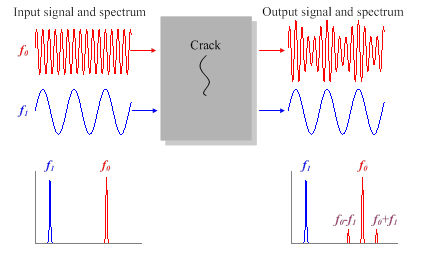Researchers at the Institute of Acoustics (IOA) of the Chinese Academy of Sciences have found that there is a critical low-frequency amplitude in vibro-acoustic modulation test. When the pumping amplitude reaches this critical value, the modulation reaches a maximum and will not change even if the pumping amplitude further increases, thus researchers find nonlinearity between modulation and amplitude.
The research was published in Structural Health Monitoring on March 1, 2018.
Vibro-acoustic modulation (VAM) is a nonlinear ultrasonic nondestructive testing method. The approach can detect material defects by monitoring the modulation components (f0 ± nf1) generated by the interaction between probing (high-frequency ultrasound f0) and pumping (low-frequency vibration f1) signals since the nonlinear behavior is caused by material damage. VAM is sensitive to cracks in structures even with complex geometries.
Parameter selection is one of the key points to guarantee test reliability. Previous studies indicate that the modulation intensity linearly increases with the pumping amplitude during testing. In this study, nine aluminum alloy rods with different length of crack were tested in the experiments, the influence of variation in the amplitude of pumping (low-frequency vibration) signals on the modulation was investigated. Dynamic strain measurement of the crack area was utilized to analyze the relation between the degree of crack opening/closing and the modulation on the crack interface.
The results indicated that the strain increases as the pumping amplitude increases, and modulation intensity (MID) increases as the pumping strain increases. While the modulation intensity does not change when the strain reaches a certain value, it was defined as critical pumping strain. Further research indicated that the opening angle of the cracks with different sizes is approximately equal at the point where the pumping strain is sufficient to “fully open” the crack interface.
This study can provide the selection principle of the pumping amplitude and support for the crack opening/closing model for the VAM technique. Further studies will be focused on the influence of probing frequency on the modulation intensity, progressively complete the parameter selection principles of this technique.

Figure 1. Principle of vibro-acoustic modulation (Image by Zagrai A, et al,2004)

Figure 2. Influence of pumping strain on modulation for different crack sizes, εc is the critical pumping strain and MID is the modulation intensity (Image by IOA)
Reference:
LIU Bin, LUO Zhiwei, GANG Tie. Influence of Low-Frequency Parameter Changes On Nonlinear Vibro-Acoustic Wave Modulations Used for Crack Detection. Structural Health Monitoring, 2018,17(2):218-226. DOI: 10.1177/1475921716689385.
Contact:
WANG Rongquan
Institute of Acoustics, Chinese Academy of Sciences, 100190 Beijing, China


